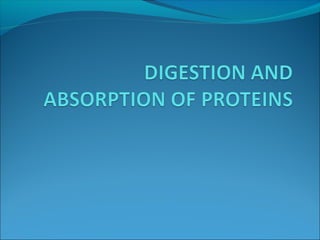
Digestion and absorption of proteins
- 2. The proteins subjected to digestion and absorption are obtained from two sources. 1.Exogenous 2.Endogenous
- 3. The Fate of Dietary Protein The intake of dietary protein is in the range of 50-100g/day. Digestion and absorption . Maintenance of body protein stores. Net protein synthesis. Synthesis of non-protein compounds Oxidative deamination
- 4. PROTEINS in the BODY Amino Acid Pool – amino acids that are available throughout the body (tissues and fluids) for use when needed. Protein Turnover – of the ~ 300 grams of protein synthesized by the body each day, 200 grams are made from recycled amino acids.
- 5. Protein Digestion Whole proteins are not absorbed. Too large to pass through cell membranes intact. H3N+ H C C O H O R N C C H Digestive enzymes.Hydrolases R N H C C O H O– Break peptide bonds R Secreted as inactive pre-enzymes. Prevents self-digestion.
- 6. Protein Digestion Initiated in stomach HCl from parietal cells StomachpH 1.6 to 3.2 Denatures 40, 30, and 20 structures Pepsinogen from chief cells Pepsinogen HCl Pepsin Cleaves only when carbonyl group of the peptide bond is contributed by Aromatic amino acids. Protein leaves stomach as mix of insoluble protein, soluble protein, peptides and amino acids
- 7. Protein Digestion – Small Intestine Pancreatic enzymes secreted Trypsinogen Chymotrypsinogen Procarboxypeptidase Proelastase Zymogens Collagenase
- 8. The release of pancreatic zymogens is mediated by the secreation of Cholecystokinin and secretin,two polypeptide hormones of digestive tract.
- 9. Digestion in Small Intestine Zymogens must be converted to active form Trypsinogen Enteropeptidase/Trypsin Trypsin Endopeptidase Cleaves on carbonyl side of Lys & Arg Trypsin Chymotrypsinogen Chymotrypsin Endopeptidase Cleaves carboxy terminal Phe, Tyr and Trp Trypsin Procarboxypeptidase Carboxypeptidase Exopeptidase Removes carboxy terminal residues
- 11. Trypsin Inhibitors Small proteins or peptides Present in plants, organs, and fluids Soybeans, peas, beans, wheat Pancreas, colostrum Block digestion of specific proteins Inactivated by heat
- 12. Protein Digestion Proteins are broken down to Tripeptides Dipeptides Free amino acids
- 14. Peptide Absorption Form in which the majority of protein is absorbed More rapid than absorption of free amino acids Active transport Energy required Metabolized into free amino acids in enterocyte Only free amino acids absorbed into blood
- 15. Free Amino Acid Absorption Free amino acids Carrier systems Neutral AA Basic AA Na+ Na+ Acidic AA Imino acids Entrance of some AA is via active transport Requires energy
- 16. Protein Digestion Small intestine (brush border) Aminopeptidases Cleave at N-terminal AA Dipeptidases Cleave dipeptides into Aas. (Enterokinase or enteropeptidase) Trypsinogen → trypsin Trypsin then activates all the other enzymes
- 17. In the Enterocytes… First cells that can use the amino acids Transport into portal blood Protein synthesis Digestive enzymes Structure and growth Energy
- 18. Basolateral Membrane Transport of free amino acids only* Peptides are hydrolyzed within the enterocyte Transport mainly by diffusion and Groff & Gropper, 2000 Na-independent carriers *Whole proteins are nutritionally insignificant...
- 19. Absorption of Intact Proteins Newborns First 24 hours after birth Immunoglobulins Passive immunity Adults Paracellular routes Tight junctions between cells Intracellular routes Endocytosis Pinocytosis Of little nutritional significance... Affects health (allergies and passive immunity)
- 20. Abnormalities in the protein digestion and amino acid absorption. Defect in the pancreatic secreation. Cystic fibrosis,incomplete digestion of fat and protein,results in abnormal appearance of lipids (steatorrhea) and proteins in feces. Defective carrier system
- 21. HARTNUP’S DISEASE Inability of itestinal and epithelial cells to absorb neutral amino acids.Tryptophan absorption is severely effected resulting in pellagra. CYSTINUREA.
